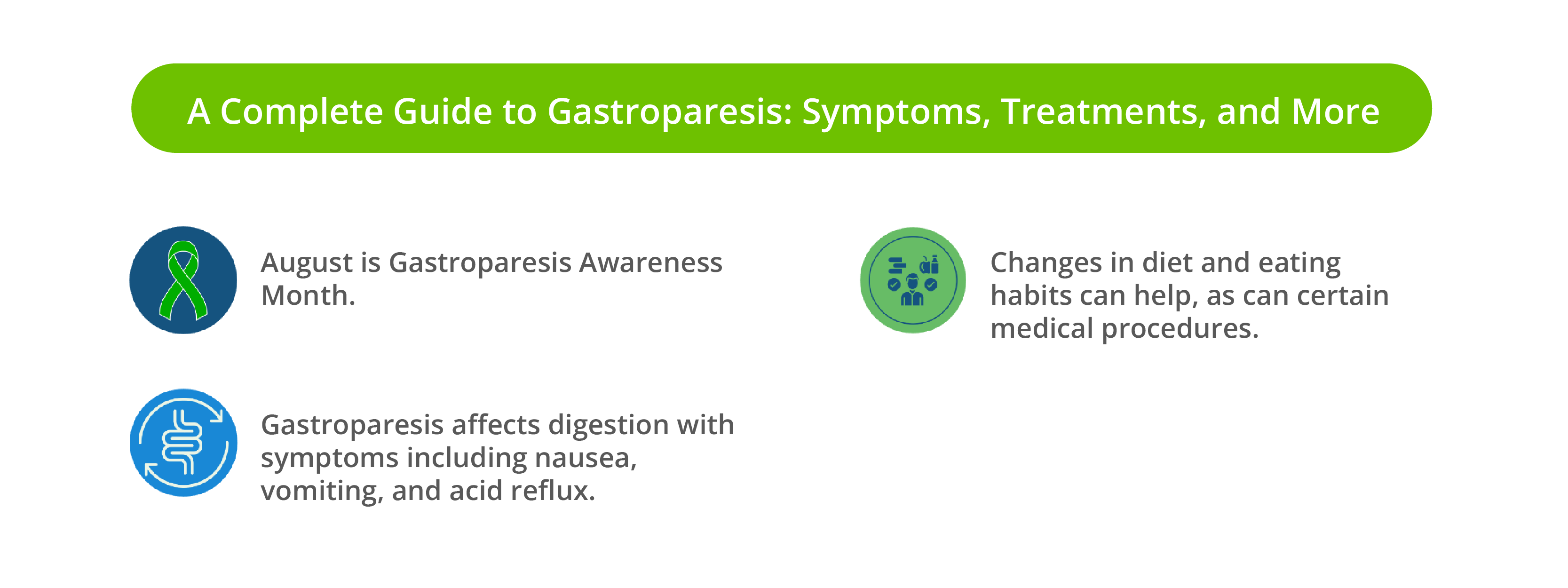
Your comprehensive guide to understanding this stomach condition and how to manage it more effectively.
Gastroparesis is a chronic condition affecting how the stomach muscles move food (peristalsis) and resulting in a delay or complete halt of food moving toward the small intestine. August is Gastroparesis Awareness Month, sponsored since 2016 by the International Foundation for Gastrointestinal Disorders (IFFGD). The IFFGD estimates that as many as 5 million people live with gastroparesis, although the actual number may be higher due to the similarities between gastroparesis symptoms and those of other conditions.
Gastroparesis causes and symptoms
Gastroparesis can occur at any age and its exact cause is uncertain, with several factors linked to its development. It can be rooted in damage to the vagus nerve, which controls the stomach muscles to keep food moving through the body. Diabetes is a common factor in gastroparesis because diabetes damages the vagus nerve.
Infections can also lead to gastroparesis, as can disorders of the thyroid gland and nervous system. Certain medications or surgical procedures on the esophagus or abdomen have also been linked to developing gastroparesis.
Understanding and managing gastroparesis requires being aware of its many symptoms, which can occur during and/or after a meal and may be more frequent and severe depending on the patient. These include:
- Stomach pain
- Abdominal bloating
- Reduced appetite
- Premature feeling of fullness
- Nausea/dry heaving
- Acid reflux
- Heartburn
- Vomiting undigested food
Some gastroparesis sufferers also experience problems with their blood sugar levels. And the interrupted digestive process leads to poorer nutrient absorption, which may cause other problems like weight loss or diarrhea.
Treatment options for gastroparesis
Your doctor can recommend several steps for managing gastroparesis. Surgical treatments include gastric electrical stimulation, a minimally invasive procedure that involves implanting a small device that emits gentle electrical pulses to the stomach muscles, aiding peristalsis. This method has been proven to reduce vomiting and improve quality of life in some patients.
Parenteral and enteral procedures are two other surgical treatments that can deliver medication and improve nutrition in gastroparesis patients. The parenteral method intravenously administers liquid nutrition. This bypasses the digestive tract, resolving the digestive issue for the duration of the treatment, which may take up to 12 hours and require repeating.
The enteral method administers liquid food via a tube into the small intestine or stomach. The tube may be inserted nasally or through the skin of the abdomen. Alternatively, enteral nutrition may be given as a drink without tubes.
Coping with gastroparesis
Patients are encouraged to stay hydrated, which helps the body digest food and flush the intestines. Being open about the condition also matters, as emotional support – from the healthcare team, family, and friends – can be extremely beneficial.
If you have a friend or loved one with the condition, it helps to learn as much as you can about gastroparesis so you can provide as much support as possible. This education can be significantly improved when gastroparesis sufferers share their own knowledge of the condition and speak to others about how they’re feeling physically, emotionally, and mentally.
Patients and caregivers are also encouraged to wear the green ribbon and use the hashtag #LivingWithGP to help raise awareness throughout August.
Diet and nutrition for gastroparesis
People with gastroparesis may have to chew their food more slowly and eat a higher number of smaller meals throughout the day. Reducing or eliminating carbonated drinks can also ease gastroparesis, as can avoiding heavy foods, which generally include those high in carbohydrates, protein, and fat. Alcohol should also be avoided due to its dehydrating and nutrient-sapping effects.
Effectively managing gastroparesis depends a lot on diet. Gastroparesis-friendly foods include eggs, soft fruits, purées, and vegetable juices. In general, low-fiber foods of any kind are easier to digest and will put less strain on the stomach. Meal plans may be medically prescribed prior to or following a gastroparesis flare-up and typically consist of three stages, all of which will be carefully monitored to ensure sufficient caloric intake.
The first stage features mostly juices and blended, smooth foods. The second adds softer solids such as peanut butter or noodles. And the third adds more protein-rich foods, usually soft and less fibrous meats like fish or chicken.
The lack of proper nutrition caused by gastroparesis can make vitamin and mineral supplements a valuable dietary addition. Protein shakes and liquid meal replacements can also help the body get the vital nutrients it needs.
Lifestyle changes
Stress management is important for holistic health, and it’s particularly beneficial to the stomach and digestive system. Try to take life as leisurely as possible. Keep circulation flowing with gentle stretching. Read a book, enjoy a bath or shower, or pursue a hobby – anything that can help you relax. Exercise can also aid digestion with the added benefit of reducing stress hormones and encouraging higher levels of hydration.
Getting a good night’s sleep is also important, as lack of sleep can lead to gastroparesis flare-ups. It’s best not to sleep within two hours of eating, however, as gravity aids digestion.
Sleeping on the stomach should be avoided as it may induce acid reflux. Sleeping on the back can also pose problems if the head isn’t sufficiently elevated. Side sleeping is therefore the recommended position for gastroparesis patients whenever possible.
Make gastroparesis less stressful with ModRN Health
There’s hope for better understanding and managing gastroparesis if researchers, sufferers, and supporters continue to work together toward more effective treatments and greater public awareness. Also on the plus side, many gastroparesis management steps can have wider health benefits!
Of course, managing any chronic condition is difficult enough without the added stress of expensive medications, and that’s where ModRN Health comes in. We help our members locate the cheapest local sources of the prescriptions they need, whether they’re brand-name or generic. Create your free account today and find out just how much money you could save.








